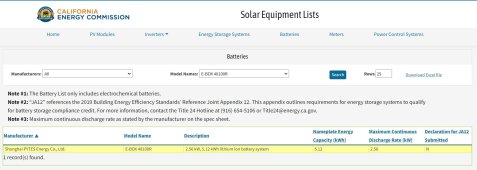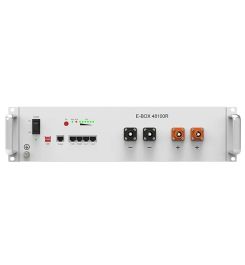Where to purchase? Also, I didn't see that on California's approved list. Pytes and GSL are on the list which is why I was asking. I guess being UL certified isn't enough by itself to meet the CA requirements.
*Edit* I was reading California's requirements and I think it's the warranty period of most of these batteries that doesn't meet the CA requirements. Here is a excerpt from the Joint Appendix 12 from the 2019 Building Energy Efficiency Standards that batteries have to comply with to meet CA standards. E4 batteries are 5 year and Ruixu are 7 year. So maybe that's why?
JA12.2.1 Safety Requirements
The battery storage
system shall be tested in accordance with the applicable requirements given in UL1973 and UL9540. Inverters used with battery storage systems shall be tested in accordance with the applicable requirements in UL1741 and UL1741 Supplement A.
JA12.2.2 Minimum Performance Requirements
The installed battery storage
system should meet or exceed the following performance specification:
(c) Usable capacity of at least 5 kWh.
(d) Single Charge-discharge cycle AC to AC (round-trip) efficiency of at least 80 percent.
(e) Energy capacity retention of 70 percent of nameplate capacity after 4,000 cycles covered by a warranty, or 70 percent of nameplate capacity under a 10-year warranty.
JA12.2.3 Control Requirements
The requirements below are applicable to all control strategies.
(a) The battery storage
system shall have the capability of being remotely programmed to change the charge and discharge periods.
(b) During discharge, the battery storage system shall be programmed to first meet the electrical load of the
dwelling unit(s). If during the discharge period the electrical load of the
dwelling unit(s) is less than the maximum discharge rate, the battery storage system shall have the capability to discharge electricity into the grid upon receipt of a
demand response signal from the local utility or a third-party aggregator.
(c) The battery storage system shall operate in one of the control strategies
listed in JA12.2.3.1, JA12.2.3.2, and JA12.2.3.3 except during a power interruption, when it may switch to backup mode. If the battery system switches to backup power mode during a power interruption, upon restoration of power the battery system shall immediately revert to the previously programmed JA12 control strategy.
(d) The battery storage system shall perform a system check on the following dates, to ensure the battery is operating in one of the control strategies listed in JA12.2.3.1, JA12.2.3.2, and JA12.2.3.3:
1) Within 10 calendar days before the onset of summer TOU schedule, and
Within 10 calendar days before the onset of winter TOU schedule. At the time of inspection, the battery storage system shall be installed to meet one of the following control strategies. The battery storage system also shall have the capability to remotely switch to the other control strategies.
JA12.2.3.1 Basic Control
To qualify for the Basic Control, the battery storage
system shall be installed in the default operation mode to allow charging only from an on-site photovoltaic system when the photovoltaic system production is greater than the on-site electrical load. The battery storage system shall discharge only when the photovoltaic system production is less than the on-site electrical load.
JA12.2.3.2 Time-of-Use (TOU) Control
To qualify for the TOU Control, the battery storage
system shall be installed in the default operation mode to allow charging from an on-site photovoltaic system. The battery storage system shall begin discharging during the highest priced TOU hours of the day. The operation schedule shall be preprogrammed from
factory, updated remotely, or programmed during the installation/commissioning of the system. At a minimum, the system shall be capable of programming three separate seasonal TOU schedules, such as spring, summer, and winter.
JA12.2.3.3 Advanced Demand Response Control
To qualify for the Advanced
Demand Response Control, the battery storage
system shall be programmed by default as Basic Control as described in JA12.2.3.1 or TOU control as described in JA12.2.3.2. The battery storage control shall meet the
demand responsive control requirements specified in Section 110.12(a). Additionally, the battery storage system shall have the capability to change the charging and discharging periods in response to signals from the local utility or a third-party aggregator.
JA12.2.3.4 Alternative Control Approved by the Executive Director
The
Executive Director may approve alternative control strategies that demonstrate equal or greater benefits to one of the JA12 control strategies. To qualify for Alternative Control, the battery storage
system shall be operated in a manner that increases self-utilization of the PV array output, responds to utility rates, responds to
demand response signals, and/or other strategies that achieve equal or greater. This alternative control option shall be accompanied with clear and easy to implement algorithms for incorporation into the
compliance software for compliance credit calculations.








